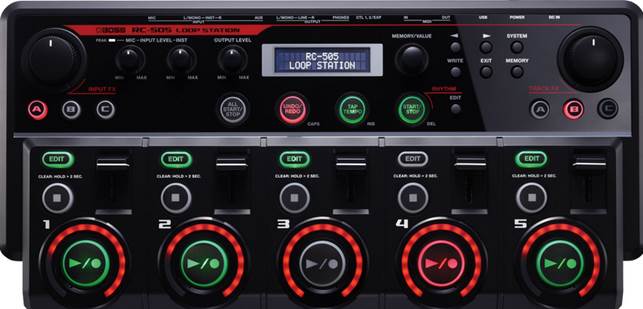Dedicated looping devices are becoming increasingly
common as competition hots up.
Loop-based recording has been commonplace both in studios and
the live world for quite a while, but the technology behind the live side of
things has been slow to develop. Artists like Ed Sheeran have helped to bring
the art of live, sound-on sound looping to the mainstream as helayers
percussive and melodic guitar sounds to provide a backing to sing over. Ed uses
a two-track looper called the RC-30, from Boss, to great effect. Like most
options out there, this is a floor pedal, and although they can be placed on a
desktop for hand operation, they don’t have the best feel and require a fair
bit of strength to operate.
With a history of creating many of the tools that helped to
shape the looping scene, Boss has now released the RC-505, which is the
company’s first desktop-oriented unit. It’s a device that has soft-touch
buttons for its main multitrack functionality.

Dedicated looping
devices are becoming increasingly common as competition hots up.
Track count
The RC-505 has five separate tracks for loop recording and
infinite additional over dubbing. The layers have undo and redo functionality
for those less than ideal takes, and these functions are all within easy reach.
Tracks can be recorded, triggered and stopped using the main round play/record
button per track, but a very short fader per track enables you to balance your
play back levels or abruptly bring tracks in or out in DJ style. These both
offer a good level of control, enabling a dynamic performance arrangement.
Capturing tracks is done in a variety of ways: using the
first recording as the basis for your tempo, feeding one of the many available
rhythm tracks to your headphones or speakers to sync with, or having certain
loops pre-recorded into the machine to layer up. A USB connection makes it easy
to move files to/from the unit and send/receive MIDI. This makes it possible
for you to sync with a computer for those with a bigger setup in mind; five-pin
MIDI IO is also available for additional hardware configurations. You have 99
presets to store your work and song setups, which can be backed up via USB as
well.

The RC-505 is
outfitted with a number of simultaneous inputs, allowing you to capture and mix
a variety of different audio sources as you build loops.
FX and performance
There are various ways to hook up to the RC-505, including
via a phantom power-capable XLR connection, an instrument input jack, or a
3.5mm stereo line input. We tested the mix inputs with a dynamic mic and a
guitar plugged into the instrument jack. The RC-505 does come with on board effects
but no amp-modelled guitar processing, so guitarists will need to consider
using an additional processor before the RC-505. Boss has thought about this
though and added a second jack to cater for the stereo output of another pedal.
Two groups of effects are available– one for input
processing as it’s captured live, and another Track FX group that processes the
master output by default. These Track FX can be assigned to any number of
individual tracks, so they are quite flexible.
Both effect groups offer the same 21 main FX options, with
an additional four time-manipulation effects available in the Track FX. These
are called Beat Repeat, Beat Shift, Beat Scatter and Vinyl Flick. All but the
last have flavours of sound re-editing on-the-fly, with the last being a
turntable stop effect. Shared FX include an octave pedal-like guitar-to-bass
effect that has a range of up to two octaves and a synth effect that can
transform your input’s pitch to a synth tone, which works surprisingly well and
has a fairly quick response time. A vocoder lets you use your input signal as a
modulator for a specified track and a variety of other extreme effects are also
available.

The FX dials are
nice and chunky so you can get your body behind them as you perform, but
there’s only one control available at a time.
Loops in action
Most of the RC-505’s controls feel intuitive and are
immediate to play with. The FX dials are nice and chunky so you can get your
body behind them as you perform, but there’s only one control available at a
time. Specific FX settings can be saved within a phrase memory so it’s easy to
recall them, it’s just ashame that there isn’t more control available by
immediate touch.
Although this unit isn’t perfect, itdoes offer a higher
level of performance options on the looping side of things by comparison to the
competition. We’ve had a lot of fun playing with it and advise you to consider
it if you want an all-in-one looping solution.
|
Specifications
·
Tabletop design ·
99 phrase memories ·
Phantom powered XLR mic input ·
5 stereo phrase tracks ·
21 Input FX and ·
25 Track FX ·
Expression and pedal switch inputs
|